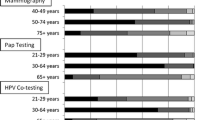Abstract
Population-based cancer screening for cervical, breast, and colorectal cancers improves patient outcomes, yet screening rates remain low for some cancers. Despite studies investigating physician perceptions and practices for screening, many have focused on individual cancers and lack primary care physicians’ (PCPs) realities around screening for multiple cancers. We surveyed 887 PCPs in British Columbia (BC) to examine practices, beliefs, barriers, and learning needs towards cancer screening across breast, cervical, colorectal, prostate, as well as hereditary predisposition to cancer. Survey results identified differences in PCPs belief in the benefit of screening for recommended and non-recommended routine cancer screening, PCPs adherence to screening guidelines for some cancers and physician comfort and patient testing requests related to physician gender for gender sensitive tests. Further, across cancers, screening barriers included patients with multiple health concerns (41%), limited time to discuss screening (36%), and lack of physician financial compensation to discuss screening (23%). The study highlighted the need for more physician education on screening programs, referral criteria, follow-up processes, and screening guidelines. Conferences (73%), self-directed (46%), small group workshops (42%), hospital rounds (41%), and online CME/CPD (39%) were highly preferred (4+5) for learning about cancer screening. The results suggest a need to improve awareness and adherence to screening guidelines and recommended practices, as well as to provide educational opportunities which address knowledge and practice gaps for physicians.

Similar content being viewed by others
References
Canadian Cancer Statistics (2016) Canadian Cancer Society’s Advisory Committee on Cancer Statistics. Canadian Cancer Society, Toronto, 2016 October. Report No: ISSN0835-2976
Sasieni P, Castanon A, Cuzick J (2009) Effectiveness of cervical screening with age: population based case-control study of prospectively recorded data. BMJ (Clin Res ed) 339:b2968
Strumpf Erin C, Chai Z, Kadiyala S (2010) Adherence to cancer screening guidelines across Canadian provinces: an observational study. BMC Cancer 10:304
Feeley TH, Cooper J, Foels T, Mahoney MC (2009) Efficacy expectations for colorectal cancer screening in primary care: identifying barriers and facilitators for patients and clinicians. Health Commun 24:304–315
Cardarelli R, Kurian AK, Pandya V (2010) Having a personal healthcare provider and receipt of adequate cervical and breast cancer screening. J Am Board Fam Med : JABFM 23:75–81
Wender RC (1993) Cancer screening and prevention in primary care. Obstacles for physicians. Cancer 72:1093–1099
Davis D, Davis ME, Jadad A, Perrier L, Rath D, Ryan D, Sibbald G, Straus S, Rappolt S, Wowk M, Zwarenstein M (2003) The case for knowledge translation: shortening the journey from evidence to effect. BMJ. doi:10.1136/bmj.327.7405.33
Davis D, O'Brien MAT, Freemantle N, Wolf FM, Mazmanian P, Taylor-Vaisey A (1999) Impact of formal continuing medical education do conferences, workshops, rounds, and other traditional continuing education activities change physician behavior or health care outcomes? JAMA 282:867–874
Davis D, Galbraith R (2009) Continuing medical education effect on practice performance: effectiveness of continuing medical education: American College of Chest Physicians Evidence-Based Educational Guidelines. Chest 135:42S–48S
Grant J (2002) Learning needs assessment: assessing the need. BMJ. doi:10.1136/bmj.324.7330.156
Curran V, Solberg S, Mathews M, Church J, Buehler S, Wells J, Lopez T (2005) Prostate cancer screening attitudes and continuing education needs of primary care physicians. J Cancer Educ: Off J Am Assoc Cancer Educ 20:162–166
McGregor SE, Hilsden RJ, Yang H (2010) Physician barriers to population-based, fecal occult blood test-based colorectal cancer screening programs for average-risk patients. Can J Gastroenterol = Journal canadien de gastroenterologie 24:359–364
Levy S, Dowling P, Boult L, Monroe A, McQuade W (1992) The effect of physician and patient gender on preventive medicine practices in patients older than fifty. Fam Med 24:58–61
Yarnall KSH, Pollak KI, Østbye T, Krause KM, Lloyd Michener J (2003) Primary care: is there enough time for prevention? Am J Public Health 93:635–641
Grol R, Grimshaw J (2003) From best evidence to best practice: effective implementation of change in patients’ care. Lancet 362(9391):1225–1230
Hoag NA, Alan IS (2012) The confusion surrounding prostate cancer screening faced by family physicians. Can Urol Assoc J 6(3):194–195
Williamson PM (1975) The adoption of new drugs by doctors practising in group and solo practice. Soc Sci Med 9(4–5):233–236
Dochy F, Segers M, Van den Bossche P, Gijbels D (2003) Effects of problem-based learning: a meta-analysis. Learn Instr 13:533–568
Marinopoulos SS, Dorman T, Ratanawongsa N, Wilson LM, Ashar BH, Magaziner JL, Miller RG, Thomas PA, Prokopowicz GP, Qayyum R, Bass EB (2007) Effectiveness of continuing medical education. Evid Report/Technol Assess 149:1–69
Pathman DE, Konrad TR, Freed GL, Freeman VA, Koch GG (1996) The awareness-to-adherence model of the steps to clinical guideline compliance. The case of pediatric vaccine recommendations. Med Care 34(9):873–889
Author information
Authors and Affiliations
Corresponding author
Rights and permissions
About this article
Cite this article
Lynn, B., Hatry, A., Burnett, C. et al. Identifying Primary Care Physicians Continuing Education Needs by Examining Clinical Practices, Attitudes, and Barriers to Screening Across Multiple Cancers. J Canc Educ 33, 1255–1262 (2018). https://doi.org/10.1007/s13187-017-1240-5
Published:
Issue Date:
DOI: https://doi.org/10.1007/s13187-017-1240-5




